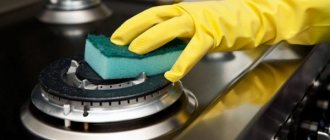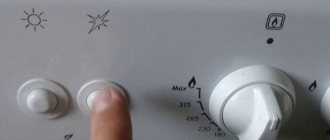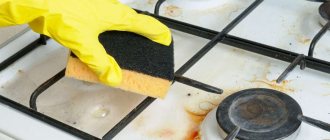Your gas stove has never let you down, but suddenly you have problems with the burners burning? The situation is, to put it mildly, unpleasant, don’t you agree? Do you want to try to restore the functionality of your equipment on your own, but don’t know where to start diagnosing?
We will help you figure out why the gas burner does not burn well, we will tell you how to find the breakdown and fix it yourself. We will also talk about the most common malfunctions that lead to problems with the combustion of a gas burner. Moreover, many of the reasons leading to abnormal operation of gas stoves can be eliminated quickly and without significant costs. Here are some illustrative photos and thematic videos.
Frequent problems and methods for eliminating them
Before starting to repair equipment, you should study its design in detail, as well as diagnose the device in order to identify the cause of the malfunction.
Frequent malfunctions and ways to eliminate them.
Poor oven heating. This problem often occurs due to a broken switch. To fix the problem, it is enough to install a working element.
Remember, if replacing the switch does not bring the desired effect, you need to check the heating coil.
To do this, you should first dismantle the rear panel of the stove body, loosening the clamping brackets of the device
If damage to the spiral is detected, it is important to replace it. In this case, the new mechanism should be installed exclusively in prepared grooves. Uneven flame length in the burner or lack of fire in the burner
As a rule, this problem occurs due to clogging of the gas channels of the stove. To restore the functional properties of the unit, you should clean the nozzle passage holes using a thin needle.
Uneven flame length in the burner or lack of fire in the burner. As a rule, this problem occurs due to clogging of the gas channels of the stove. To restore the functional properties of the unit, you should clean the nozzle passage holes using a thin needle.
However, if this procedure does not resolve the problem, you will need to check the spark plug insulation for leaks and the solenoid valve's structural integrity. If any malfunctions are detected, the worn element should be replaced.
- The appearance of extraneous sounds during gas combustion. This problem often occurs when the balance of the air-gas mixture is disturbed. When using old kitchen stoves, adjusting the air damper of the device will help eliminate the problem. To eliminate noise, when operating devices of a new type, all flame dividers are replaced.
- Spontaneous extinguishing of the gas burner. When the stove is operating properly, the flame from the burner “washes” the thermocouple. However, if the fire does not reach the element, the burner may spontaneously go out. To eliminate the malfunction, you should clean the stove nozzle from dirt or adjust the gas supply.
- The flame goes out in the oven. Modern gas stoves are often equipped with a gas control system. Thanks to the presence of this function, when the flame in the oven goes out, the fuel supply is automatically blocked. In this case, the sensor, when cooled, transmits a signal to the valve of the device, which shuts off the passage channels of the furnace. However, if there is a malfunction in the gas control design, the flame in the oven burns only when the ignition button is pressed. As a rule, after stopping the impact on the key, the burner spontaneously extinguishes.
This problem often occurs when the thermocouple is not cooled quickly enough. As a rule, in the process of heating this element, an electric current is generated. In this case, the flow, holding the magnetic valve in the pressed position, does not allow the resource to close the passage hole of the nozzle.
To restore full operation of the unit, the thermocouple should be cleaned of dirt. This procedure is performed using sandpaper.
If cleaning the thermocouple from dirt does not bring the desired result, it is necessary to replace the faulty mechanism.
Poor supply of gas burner flame. This problem often occurs when the holes in the jets that spray fuel become clogged.
Regular cleaning of the injector clearances will help prevent excessive dirt accumulation.
The second reason for poor flame pressure is the incorrect ratio of the air-gas mixture that flows to the burner. If it is necessary to increase the burning intensity of the fire, the air damper of the stove should be adjusted.
Remember, improperly repaired kitchen appliances can lead to gas leaks and explosions.
Step-by-step troubleshooting instructions
Algorithm for identifying the most common equipment failures:
- Check the presence of voltage at the terminals of the supply cable using a voltmeter. After making sure that power is supplied to the control panel, press the “Sand” button. Sound and light indications are activated on the touch panel.
- At the input circuit breaker located in the power supply distribution board, the voltage at the upper contacts is checked. This process is carried out using a multimeter, a low voltage indicator (LV) and a single-pole indicator.
- The supply of voltage to the mechanical and electronic control mechanism is carried out using a special unit. To check the serviceability of the cooking zones, it is necessary to measure the electric current one by one with an ammeter.
- Tubular electric heaters, temperature measurement sensors, electrical switches, make and break contacts, and all kinds of regulators are checked for malfunctions and to detect the causes of device failure.
How to fix an electric ignition yourself
In order to repair the electric ignition of a gas stove, you first need to find the cause of the problem. If you are unsure of your knowledge, you should not start repairing it yourself; it is better to entrust this matter to a specialist. Well, if you decide to repair a gas stove with your own hands, below are the methods in the form of instructions for this process:
- Initially, you need to light the faulty burner manually or using matches. If the gas burns properly, the flame will be blue and uniform. The faulty element burns with a yellow or sluggish flame. If gas combustion occurs only on one side of the burner, it means that the divider is uneven or deformed. The problem occurs due to a malfunction in the fuel mixture ratio, which is why the burner does not ignite from a spark. You can fix the problem with electric ignition yourself by cleaning the injectors and reinstalling the divider.
- All electrodes, ignited by a spark, are powered through the ignition unit, and in order to turn on the unit, you need to use different buttons. Try using the following ignition scheme: light one burner by pressing the button while holding down the second one. This method is relevant if the first part did not ignite manually when the gas tap was open, but a spark did not form. If this burner did not give a spark this time (one of the two clamped), we can conclude that the electric ignition switch is broken.
- If, when trying to light the hob, the ignition starts to crackle continuously, this may be due to the contacts of one of the switches closing. This can happen due to moisture or grease getting into the middle of the structure, as well as due to oxidation or bending of the contacts. In order to solve this problem with a gas stove, you need to clean and dry all the elements. Carrying out preventive maintenance will affect the return of equipment to serviceable condition.
The burner burns intensely with flame breaks
Burner flames are dangerously large and burst. This indicates that the gas pressure supplied to the stove is too high. How to set the stove to the desired pressure is described at the end of the article. If there are problems with only one burner, then it is likely that the wrong nozzle is installed in this burner (factory defect).
If you use bottled gas and according to the papers the pressure is correct, but the stove still burns either too intensely or too weakly, then the reducer is probably faulty.
Why does a gas stove burner burn poorly?
Interruptions in the operation of the burner are the most common problem when using a gas stove. Signs of its occurrence are a change in the shade of the fire that comes out of the burner, as well as a sharp increase or decrease in its value. The situation when the flame breaks off or some strange sounds appear is also not considered normal. Let us remind you that gas stoves are famous for their noiselessness.
Typically, any malfunction of the device is a consequence of a number of things. The most common reasons are:
- violation of the internal structure of the unit;
- damage to the gas hose;
- lack of gas fuel;
- low gas pressure;
- Incorrect burner selection.
The burner does not burn well and makes sounds
The burner is an integral part of any gas stove, a key working element needed for cooking. Externally, it is the end of a gas valve. The burner is involved in mixing and preparing the air-gas mixture required for normal functioning. It takes on maximum thermal loads. Over time, due to thermal effects, the components of this assembly are deformed, their fit to each other becomes loose. All these changes are reflected in the combustion mode - it is disrupted because air entering through the organized cracks interferes with the process. The flame goes out. The operation of the burner begins to be accompanied by the production of soot, and the color of the emerging flame becomes red. Another consequence is that the device generates inappropriate noise.
It should also be remembered that over time there is a gradual narrowing of the holes (nozzles). The reason is that with prolonged use, carbon deposits form (it is formed by food residues, household detergents, and fatty particles). A dirty burner can simply be washed thoroughly. If it is deformed, the solution should be an urgent replacement.
The oven burner burns with a red flame, with a gap
Sometimes the oven burner burns red. Or, conversely, flame separation occurs, that is, opposite some burner holes the flame does not burn or periodically goes out. If the gas pressure is normal and the nozzle is clean, then this is due to the installation of the gate (Fig. 2. B). The gate is a regular elastic plate, bent into a ring and inserted into a hole. By moving it, you can adjust the proportions of mixing gas and air. If you move the gate closer to the nozzle, there will be little air, the flame will burn with red tongues. If you move the gate away from the nozzle, there will be more air, the flame will burn intensely, with separation. We need a golden mean.
A crack has appeared on the ceramic automatic ignition spark plug
The automatic ignition system is the most unreliable and capricious thing in the entire stove. Breakdowns here are not uncommon, especially given the poor quality of some gas stoves. Normally, the system should work without failures. By the way, I have seen excellent “seven-core” ignition in Gorenje and Smeg gas stoves.
During diagnosis, the first thing to examine is the electrodes. An electrode is a ceramic candle, a rod if you like, that has a metal core. You should carefully inspect it to make sure there are no mechanical damage or cracks. The candle itself must be securely fixed next to or inside the burner.
A sign of a crack is sparking on some burners. They will require replacement spark plugs. To access damaged parts, the cooking table is disassembled. The spent candle is disconnected from the burners (by the way, there are locking rings here, they cannot be lost) and from the impulse block. A new one is installed to replace the worn-out node and the connection is made.
Tip from the expert: never press the ignition button if the burners are removed from the stove. This way you will get a breakdown.
How to clean a gas burner
We repeat that if you do not have relevant experience in repairing household appliances or electronics, then it is better not to attempt to repair a gas stove yourself. But you can clean the burner completely without fear. Firstly, it is useful to do this for prevention, and secondly, sometimes it is the blockage that is the problem of malfunctions with the stove. Follow these simple instructions to clean your gas burner yourself:
- Remove the top grate and the divider (the metal cover on the burner) from the stove, then remove the burner itself.
- Remove the screws to access the injector.
- Remove any remaining food or other debris that may have gotten under the burner;
- Prepare a cleaning solution from dish detergent and water (10:1 ratio). Soak the burner and other previously removed parts in this solution. You can rub the parts with a toothbrush or a simple sponge.
- Rinse the parts with clean water and wipe dry. Clean the nozzle with a wooden toothpick. Many people do not recommend using thin sewing needles for this purpose, as they can break and get stuck in the hole. Getting them out of there is very problematic.
- Reassemble all the parts and the stove is ready for use again.
Timely maintenance and regular cleaning of the gas stove will help prevent the appearance of soot, clogging of nozzles, as well as interruptions in the operation of burners. We hope that our recommendations will help you solve problems with poor combustion of burners, and in our catalog you will find all the necessary spare parts for repairing gas stoves.
- New materials
- Popular
March 20, 2019Refrigerators NOU FROST. Operating principle and possible malfunctions
All about no frost refrigerators
March 13, 2019Repairing a gas stove door at home
How to replace a gas stove door yourself
April 14, 2020 Place an order on the website “Spare Part for Everyone” June 17, 2019 Problems with opening the dishwasher door Why the dishwasher door does not lock and how to fix it June 18, 2019 Water is running from under the washing machine What to do if water is pouring from behind the washing machine May 19, 2019 Decoding common error codes on the coffee machine display Codes errors in coffee machines Delonghi, BOSCHFebruary 19, 2019Blender attachment repair at home
Types of breakdowns and their repair
October 11, 2018How to choose a refrigerator - expert advice
The specialists at All Spare Parts offer detailed instructions on choosing a refrigerator for your home.
All news
Cleaning and prevention
It is better to prevent any malfunction than to eliminate it. By observing the operating conditions of the gas stove, you will extend its service life, avoiding unforeseen repairs. Preventative care and cleaning:
- Clean the surface of the stove from food debris after each cooking, waiting until the panel has cooled down.
- Do not leave the stove turned on unattended, as boiling liquid from the containers floods the flame of the burners, which leads to premature wear of the auto-ignition and gas control systems.
- Do not forget to lubricate the rubbing surfaces of the adjustment knobs.
- Cleaning of burners, jets, connections of regulators and switches is done with a needle or thin wire; metal brushes and brushes are also suitable.
- Maintenance is carried out periodically. To do this, the protective panel is dismantled, the studs are removed, the rods are pulled out, the parts are cleaned and inspected for mechanical damage and signs of wear. Contacting and mating elements are lubricated with graphite lubricant.
The hob is becoming increasingly common in modern kitchens due to its convenience, expanded functionality and improved appearance. We talked about the signs, causes of malfunction and self-repair of hobs in our materials. You may find the advice of our experts useful on how to repair induction cookers, timers, oven doors, electrical appliances with ceramic and glass-ceramic surfaces, and electric stove ovens.
Repairing a gas stove seems like a difficult task. Armed with the necessary tools and troubleshooting instructions, you can repair your home appliances yourself and save a significant amount.
Methods for cleaning gas burners
In order not to spend money on purchasing special means for cleaning stubborn dirt, you can use traditional methods:
- Using table vinegar. Remove the burners from the stove. Disassemble them into two parts: the divider and the lid. Then, take a large saucepan, pour a liter of boiling water into it, pour in half a glass of table vinegar. Place the burners in the resulting liquid for half an hour. After that, remove the parts, rinse them in clean water, and wipe dry with a soft cloth. The dirt should come off completely. Put the burners in place and check them for serviceability.
- Using baking soda. It will certainly be found in any home. Baking soda copes especially well with stubborn greasy stains. Initially, remove the burners and wash them in a soapy, detergent-based solution to remove soot and deposits. Take 4 tablespoons of baking soda in a bowl and add water to make a thick paste. Using a sponge, apply the resulting mixture to the burners. Leave in this state for half an hour. Then use a toothbrush to clean all the gaps on the divider so that no dirt particles remain. Rinse them in clean water and dry them with a towel or napkin.
- Detergent for cleaning burners. Soaking parts in soapy water is another effective and inexpensive way to clean dirt from burners. Fill a bowl with two liters of hot water and dissolve 4 tablespoons of any dishwashing detergent. Place the removable parts of the burners in the resulting liquid for one hour. After the specified time, rinse the parts in clean water and wipe dry with a towel. Assemble the gas stove.
Ignition produces a spark, but the burner does not ignite
If a spark occurs when turned on, but no fire occurs, the reason is the thermocouple. It is necessary to intercede if repair is impossible. Updating the solenoid valve also gives a positive result. After this, the stove works stably.
Advice! Check the picture of the ignition unit - if it is in order, but a spark does not occur, the problem lies in the unit or power supply wire.
If there is a spark, the dust burns, but goes out quickly, press the button to supply gas for a long time. Perhaps the sensors responsible for supplying the flame do not have time to warm up.
Incorrect setting
If the gas stove is powered by a central system, there is a high probability of a problem arising due to incorrect settings of the device. Then you should seek help from specialists. Sometimes consumers try to solve the problem on their own, which is possible if you study the following features of the internal structure of the burner:
The burner includes a divider - this is a special part, externally similar to a flange bushing. To ensure uniform gas distribution, the divider has tower teeth located along the entire perimeter.
- A cover is placed on the divider - a special round stainless steel plate.
- Some models are equipped with an electric ignition system, so under the burner you can find a candle located on the side of the divider. In such models, the gas stove must be ignited by a spark.
Device under the burner with electric ignition
- In modern models, under the burner you can find a sensor that determines whether the burners are burning. If the gas does not burn, it means that its supply has stopped.
- When you remove the lid and divider from the burner, you can see the jet - this is a special part that looks like a small bolt with a hole punched along the axial direction.
Modern model of a gas stove and a disassembled burner
Results of the work done
After gas supply and control washing, no gas leaks were detected! The faucet is sealed and works much more pleasantly, without jamming!
Alexander Birzhin, rmtn.ru
Details Published 12/20/2016 16:38
What should we do if we smell an unpleasant gas smell in the kitchen? There is a high probability that this is leaking from the gas valve, which is located directly in front of the device.
As soon as you hear the smell, you should call emergency services, because the gas is highly explosive.
But it’s also worth knowing how to deal with such situations yourself. If the valve is to blame for the leak, then it is better to replace it; for polypropylene pipes, a frialen 63 ball valve is suitable. But simply lubricating the faucet may be enough. To do this, we will study in detail the instructions on how to carefully lubricate the faucet.
Flat slot screwdriver
Rag
Gag
Graphite, solid oil or technical Vaseline
Soap
1
Examine the gas tap, paying attention to how the main part of the tap is made. It can be made in the form of a cone with a hole all the way through, or pressed with a twisting spring using a special plug. Unplug all electrical appliances;
Unplug all electrical appliances;
Ask all uninvolved people to leave the room, if possible, the premises.
Make sure there is no open flame in the room and never smoke while working.
3. Next, unscrew and remove the valve from the faucet and gag it to reduce the gas flow. Carefully remove all old grease with a dry cloth and apply new grease without filling the holes.
4. After everything is done, you need to very quickly replace the gag in the gas tap with a bolt. Carefully twist the spring and clamp it with a plug. We resume the gas supply if you shut it off earlier.
5. Ventilate the room well. Then prepare a solution of soap and apply it to the tap. If there are no bubbles, then you have done the job. But still, when there are bubbles, try to assemble the faucet again and check for leaks in the same way. When the problem persists in this case, urgently call the gas service. Since even the smallest leak can lead to a destructive explosion.
Gas is the main assistant to the cook and fireman; with it you will not be cold and hungry. Knowing the safety rules and behavior patterns during emergency situations will protect you from harm and help strengthen your “friendship” with the gift sent to us by Mother Nature. Still don’t know what to do when the gas tap in the kitchen leaks and how to check if there is a leak? Well, let's get down to business then.
Manifestation of breakdown
Each problem has characteristic manifestations. Burner malfunctions include:
- change in flame color: instead of blue, it may become yellow or orange;
- low burning fire;
- the burner begins to light poorly;
- the appearance of a gas odor (usually it is quite weak, since it is not due to a leak).
If you find these signs, try to contact your gas service or service center. If this is not done, then this will lead to bad consequences: from complete breakdown of equipment to a household gas explosion.











